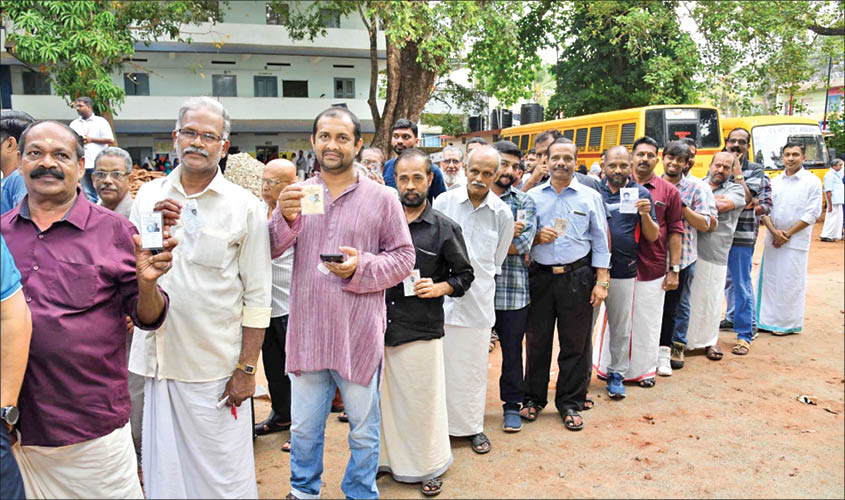For first time Kerala witnesses a triangular fight among UDF, LDF and NDA.
New Delhi: Kerala is on the edge. This is perhaps the first time the highly politically conscious state has to wait for a month to know the outcome of a Lok Sabha election.
Kerala voted on April 23, the third phase of polling, and the results will be out only on 23 May. This also is the first time the state has witnessed a truly three-cornered fight in at least half of the 20 Lok Sabha seats.
This time the BJP-led National Democratic Alliance put up a brave front against the decades-old bipolar politics of the Congress-led United Democratic Front and the CPM-led Left Democratic Front. In their post-poll analyses, all three Fronts are claiming victory, with both UDF and LDF staking claim on at least 18 seats. The NDA is modest enough to expect to win in two of the five seats where it had put up a stiff fight. More than the NDA, the elections are crucial for the other two, the Congress and the CPM.
For the Left it is a question of survival since it cannot expect any seats from its other two one-time citadels—West Bengal and Tripura. Kerala is its last bastion from where it hopes to win maximum seats, Tamil Nadu being the other one where it is contesting in two seats being part of the DMK-led alliance. It needs to win a minimum of ten seats to be in the reckoning as a national party. That is one reason the Left this time decided to fight all the 20 seats in Kerala, 16 for CPM and four for CPI. The UDF, on the other hand, was fighting to retain the 12 seats it won in 2014; the rest eight went to the LDF, with the Modi wave that swept across North India failing to have any effect in the southern state. This time too there is no Modi wave in the state, but BJP’s “Save Sabarimala” campaign against the Supreme Court ruling allowing women of all ages into the Lord Ayyappa temple has created a sort of wave in three seats: Thiruvananthapuram and Pathanamthitta in the south and Thrissur in central Kerala.
What stumped many political pundits was the voter turnout in the state. Kerala recorded the highest polling in the past three decades with 77.68% turnout. While Kannur in the north recorded the highest percentage of 83.05%, capital Thiruvananthapuram observed the lowest polling with 73% of the electorate coming out to vote. It was back in the 1989 Parliamentary elections that the southern state had witnessed a polling of 79.3%.
Generally when the polling is high, it is considered favourable to the UDF and Congress in particular. But what was significant this time was the turnout of women and members of the minority communities in very large numbers, especially in south and central Kerala and the Wayanad constituency, which shot into prominence after Congress president Rahul Gandhi decided to contest from there. This signifies two things: Large turnout of women is attributed, somewhat rightly too, to the Sabari mala imbroglio. The government high-handedness against Lord Ayyappa’s devotees has not gone down well with the women in the majority community. In fact it was the 50,000-odd apolitical women who took to the streets of Pandalam, adjacent to the Lord Ayyappa shrine, on 1 October, protesting against the SC verdict that turned the tide, with the BJP and the Congress sensing a grand political opportunity to capitalise on awaiting them. It is anybody’s guess as to where this vote share would have gone, but it definitely cannot be for the Left. Hence there is every reason to believe that this vote, especially in Pathanamthitta, abode of Lord Ayyappa, and Thiruvananthapuram might be in favour of the BJP, which put up strong candidates in these two places. Second, there is a consolidation of minority votes this time thanks to Rahul Gandhi’s candidature from the state. His presence had not created any wave in favour of the Congress as claimed by certain top leaders of the party, but it has helped mobilise minority vote behind the Congress. BJP president Amit Shah contributed his bit to this by his “mini-Pakistan” comment about Wayanad.
Even if BJP doesn’t open its account in the state—in all probability it will push LDF to third position in three constituencies—the rise of the saffron party is ominous for both the Left and the Right. For the Left, it may be a turn in the direction of Bengal where it has been pushed to third position by the BJP. To think of it, after the 2016 Assembly election, when the BJP increased its vote share, the party has been in a limbo. The state unit’s constantly bickering leadership was in disarray. A “corruption-free” party came under the glare of medical admission scam. The RSS too was unhappy after its pracharak Kummanam Rajasekharan, now a strong contender for a Lok Sabha seat from the state capital, was shunted out of the state, apparently without its permission. It was then the Pinarayi government offered the BJP Sabarimala on a platter. As we see it today, Lord Ayyappa has helped the party revive its sagging fortunes. There are many in the CPM who believes that Pinarayi is indeed lording over the party’s downfall in the state. The Congress, the frontrunner this time, will find it difficult to keep its flock together in the event of a setback in this election. BJP will be the natural choice of any Congressman intending to change sides. Not that the communists will be averse to rubbing shoulders with Congressmen. Much of the state’s future politics will depend on how the rest of India votes.

